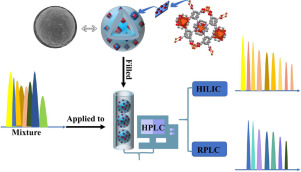Abstract
Here, silica microspheres were decorated with two-dimensional metal-organic frameworks (2D MOFs) nanosheets and ionic liquids, and evaluated as the mixed-mode stationary phase for chromatographic separation. The ionic liquids were used to assist the synthesis of 2D MOFs nanosheets, and also acted as adhesives among the nanosheets and silica. In contrast with the 2D MOFs-based column without ionic liquids and commercial columns, the prepared column exhibited enhanced chromatographic separation performance for partially hydrophilic compounds such as alkaloids, sulfonamides and antibiotics, etc. In addition to excellent chromatographic repeatability and stability, it has also been verified that the composites could be easily and repeatedly prepared. The relative standard deviation of the retention time of the same type of analyte between the three batches of materials was ranging from 0.21% to 1.7%. In short, these results indicated that the synthesized composites were promising separation material for liquid chromatography, which made it possible to broaden the application of 2D MOFs in the field of chromatography. (C) 2022 Published by Elsevier B.V. on behalf of Chinese Chemical Society and Institute of Materia Medica, Chinese Academy of Medical Sciences.
Keywords Plus:METAL-ORGANIC FRAMEWORKSSEPARATIONCHEMISTRY
Published in CHINESE CHEMICAL LETTERS,Volume33;10.1016/j.cclet.2021.10.048,AUG 2022
Here, silica microspheres were decorated with two-dimensional metal-organic frameworks (2D MOFs) nanosheets and ionic liquids, and evaluated as the mixed-mode stationary phase for chromatographic separation. The ionic liquids were used to assist the synthesis of 2D MOFs nanosheets, and also acted as adhesives among the nanosheets and silica. In contrast with the 2D MOFs-based column without ionic liquids and commercial columns, the prepared column exhibited enhanced chromatographic separation performance for partially hydrophilic compounds such as alkaloids, sulfonamides and antibiotics, etc. In addition to excellent chromatographic repeatability and stability, it has also been verified that the composites could be easily and repeatedly prepared. The relative standard deviation of the retention time of the same type of analyte between the three batches of materials was ranging from 0.21% to 1.7%. In short, these results indicated that the synthesized composites were promising separation material for liquid chromatography, which made it possible to broaden the application of 2D MOFs in the field of chromatography. (C) 2022 Published by Elsevier B.V. on behalf of Chinese Chemical Society and Institute of Materia Medica, Chinese Academy of Medical Sciences.

Keywords Plus:METAL-ORGANIC FRAMEWORKSSEPARATIONCHEMISTRY
Published in CHINESE CHEMICAL LETTERS,Volume33;10.1016/j.cclet.2021.10.048,AUG 2022


